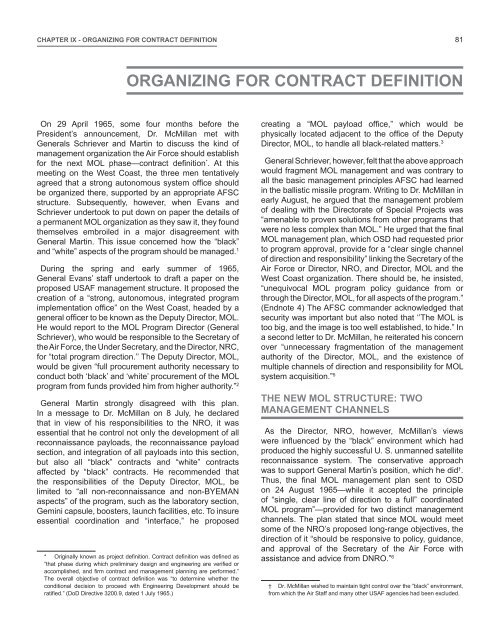NRO-MOL_2015
Create successful ePaper yourself
Turn your PDF publications into a flip-book with our unique Google optimized e-Paper software.
Chapter IX - ORGANIZING FOR CONTRACT DEFINITION<br />
81<br />
Organizing for Contract Definition<br />
On 29 April 1965, some four months before the<br />
President’s announcement, Dr. McMillan met with<br />
Generals Schriever and Martin to discuss the kind of<br />
management organization the Air Force should establish<br />
for the next <strong>MOL</strong> phase—contract definition * . At this<br />
meeting on the West Coast, the three men tentatively<br />
agreed that a strong autonomous system office should<br />
be organized there, supported by an appropriate AFSC<br />
structure. Subsequently, however, when Evans and<br />
Schriever undertook to put down on paper the details of<br />
a permanent <strong>MOL</strong> organization as they saw it, they found<br />
themselves embroiled in a major disagreement with<br />
General Martin. This issue concerned how the “black”<br />
and “white” aspects of the program should be managed. 1<br />
During the spring and early summer of 1965,<br />
General Evans’ staff undertook to draft a paper on the<br />
proposed USAF management structure. It proposed the<br />
creation of a “strong, autonomous, integrated program<br />
implementation office” on the West Coast, headed by a<br />
general officer to be known as the Deputy Director, <strong>MOL</strong>.<br />
He would report to the <strong>MOL</strong> Program Director (General<br />
Schriever), who would be responsible to the Secretary of<br />
the Air Force, the Under Secretary, and the Director, NRC,<br />
for “total program direction.’’ The Deputy Director, <strong>MOL</strong>,<br />
would be given “full procurement authority necessary to<br />
conduct both ‘black’ and ‘white’ procurement of the <strong>MOL</strong><br />
program from funds provided him from higher authority.” 2<br />
General Martin strongly disagreed with this plan.<br />
In a message to Dr. McMillan on 8 July, he declared<br />
that in view of his responsibilities to the <strong>NRO</strong>, it was<br />
essential that he control not only the development of all<br />
reconnaissance payloads, the reconnaissance payload<br />
section, and integration of all payloads into this section,<br />
but also all “black” contracts and “white” contracts<br />
affected by “black” contracts. He recommended that<br />
the responsibilities of the Deputy Director, <strong>MOL</strong>, be<br />
limited to “all non-reconnaissance and non-BYEMAN<br />
aspects” of the program, such as the laboratory section,<br />
Gemini capsule, boosters, launch facilities, etc. To insure<br />
essential coordination and “interface,” he proposed<br />
* Originally known as project definition. Contract definition was defined as<br />
“that phase during which preliminary design and engineering are verified or<br />
accomplished, and firm contract and management planning are performed.”<br />
The overall objective of contract definition was “to determine whether the<br />
conditional decision to proceed with Engineering Development should be<br />
ratified.” (DoD Directive 3200.9, dated 1 July 1965.)<br />
creating a “<strong>MOL</strong> payload office,” which would be<br />
physically located adjacent to the office of the Deputy<br />
Director, <strong>MOL</strong>, to handle all black-related matters. 3<br />
General Schriever, however, felt that the above approach<br />
would fragment <strong>MOL</strong> management and was contrary to<br />
all the basic management principles AFSC had learned<br />
in the ballistic missile program. Writing to Dr. McMillan in<br />
early August, he argued that the management problem<br />
of dealing with the Directorate of Special Projects was<br />
“amenable to proven solutions from other programs that<br />
were no less complex than <strong>MOL</strong>.” He urged that the final<br />
<strong>MOL</strong> management plan, which OSD had requested prior<br />
to program approval, provide for a “clear single channel<br />
of direction and responsibility” linking the Secretary of the<br />
Air Force or Director, <strong>NRO</strong>, and Director, <strong>MOL</strong> and the<br />
West Coast organization. There should be, he insisted,<br />
“unequivocal <strong>MOL</strong> program policy guidance from or<br />
through the Director, <strong>MOL</strong>, for all aspects of the program.”<br />
(Endnote 4) The AFSC commander acknowledged that<br />
security was important but also noted that ‘’The <strong>MOL</strong> is<br />
too big, and the image is too well established, to hide.” In<br />
a second letter to Dr. McMillan, he reiterated his concern<br />
over “unnecessary fragmentation of the management<br />
authority of the Director, <strong>MOL</strong>, and the existence of<br />
multiple channels of direction and responsibility for <strong>MOL</strong><br />
system acquisition.” 5<br />
The New <strong>MOL</strong> Structure: Two<br />
Management Channels<br />
As the Director, <strong>NRO</strong>, however, McMillan’s views<br />
were influenced by the “black” environment which had<br />
produced the highly successful U. S. unmanned satellite<br />
reconnaissance system. The conservative approach<br />
was to support General Martin’s position, which he did † .<br />
Thus, the final <strong>MOL</strong> management plan sent to OSD<br />
on 24 August 1965—while it accepted the principle<br />
of “single, clear line of direction to a full” coordinated<br />
<strong>MOL</strong> program”—provided for two distinct management<br />
channels. The plan stated that since <strong>MOL</strong> would meet<br />
some of the <strong>NRO</strong>’s proposed long-range objectives, the<br />
direction of it “should be responsive to policy, guidance,<br />
and approval of the Secretary of the Air Force with<br />
assistance and advice from D<strong>NRO</strong>.” 6<br />
† Dr. McMillan wished to maintain tight control over the “black” environment,<br />
from which the Air Staff and many other USAF agencies had been excluded.

















